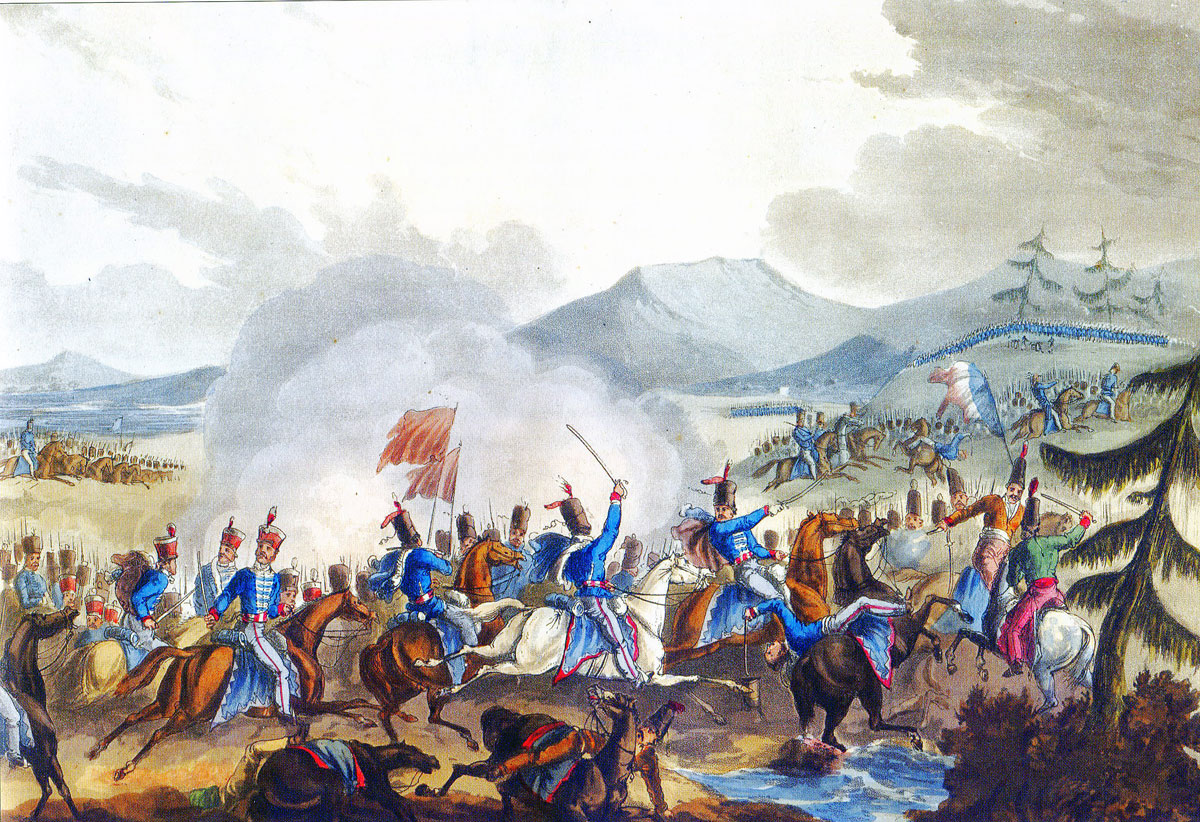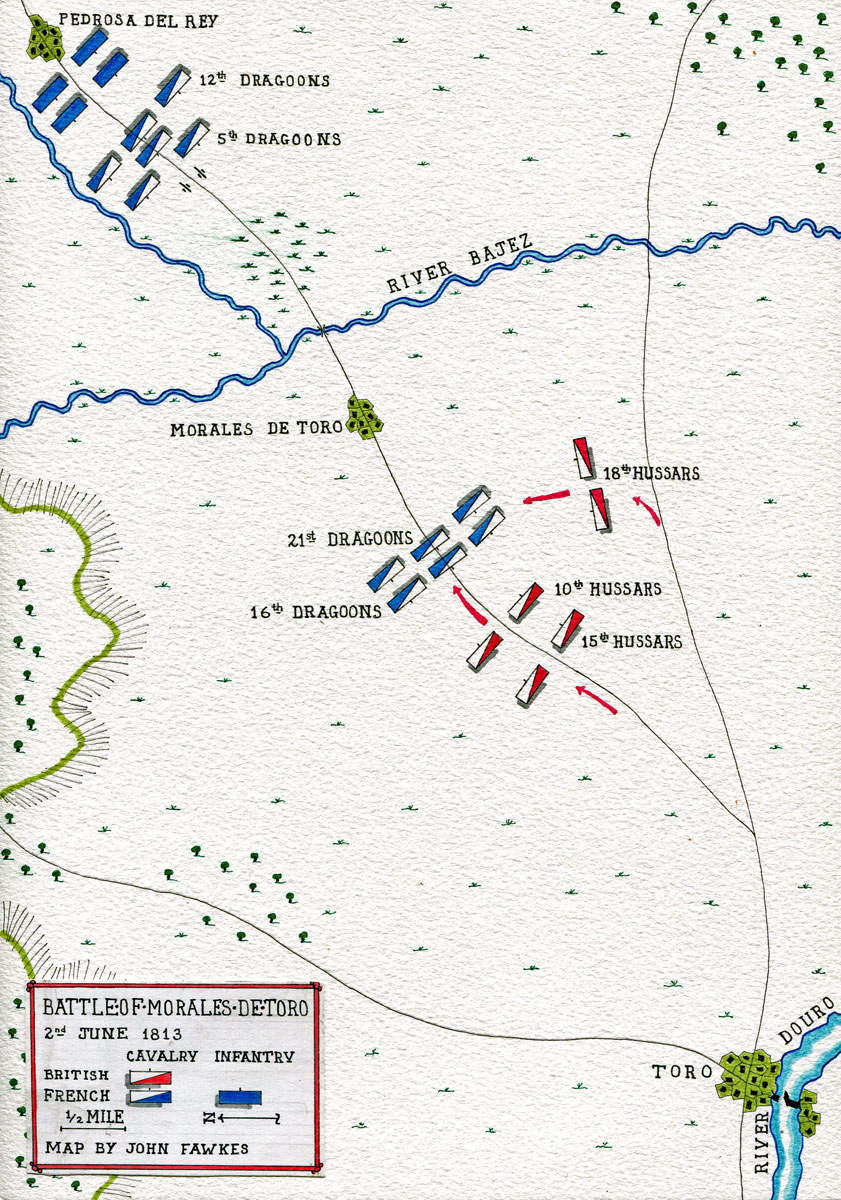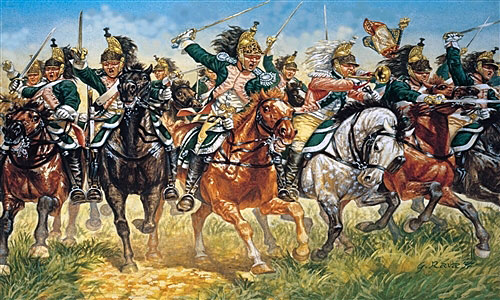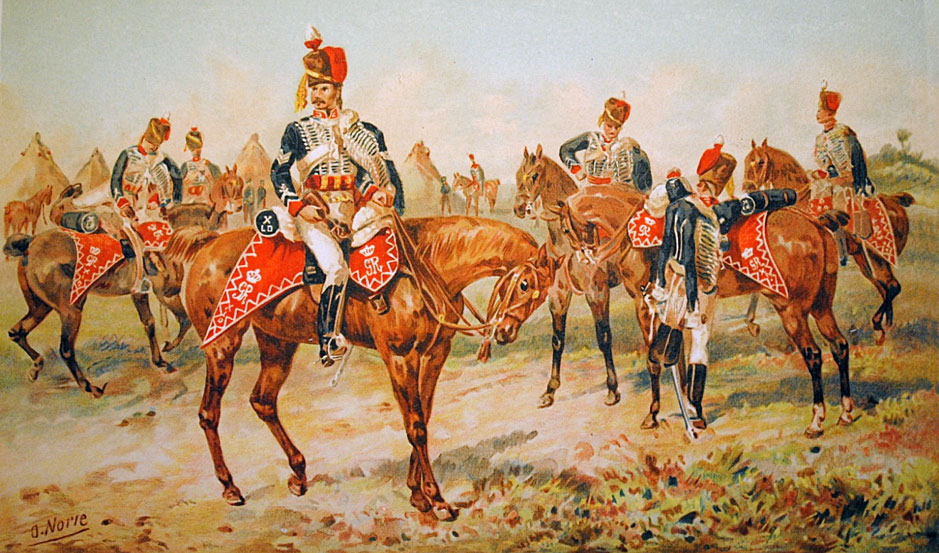The successful cavalry action fought by the British Hussar Brigade against the French 16th and 21st Dragoons on 1st June 1813, during the Peninsular War
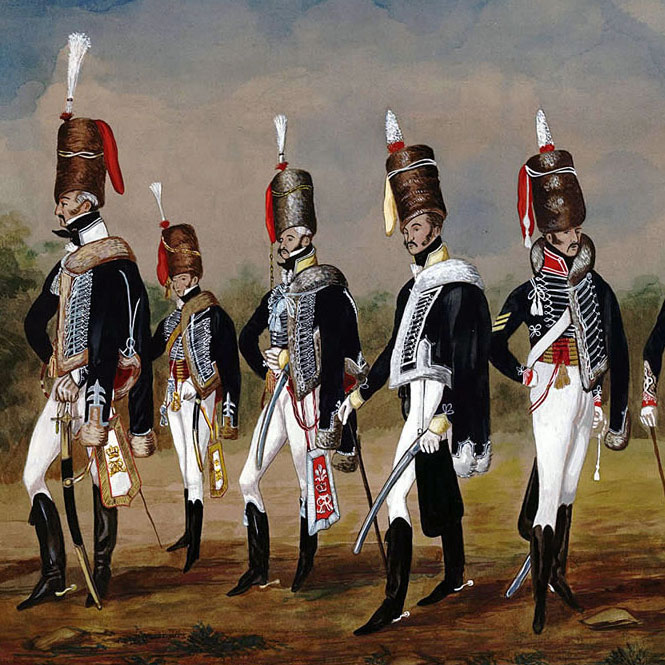 Podcast on the Battle of Morales de Toro: The successful cavalry action fought by the British Hussar Brigade against the French 16th and 21st Dragoons on 1st June 1813 in the Peninsular War: John Mackenzie’s britishbattles.com podcasts
Podcast on the Battle of Morales de Toro: The successful cavalry action fought by the British Hussar Brigade against the French 16th and 21st Dragoons on 1st June 1813 in the Peninsular War: John Mackenzie’s britishbattles.com podcasts
The previous battle of the Peninsular War is the Retreat from Burgos
The next battle of the Peninsular War is the Battle of San Millan and Osma
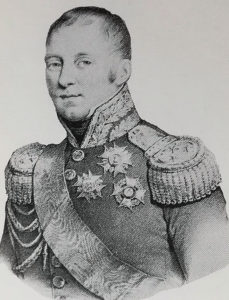
General de Division Alexandre Digeon, French commander at the Battle of Morales de Toro on 2nd June 1813 during the Peninsular War
War: Peninsular War
Date of the Battle of Morales de Toro: 2nd June 1813
Place of the Battle of Morales de Toro: On the River Douro, to the west of Valladolid, in Spain.
Combatants at the Battle of Morales de Toro: British 10th, 15th and 18th Hussars against the French 16th and 21st Dragoons.
Commanders at the Battle of Morales de Toro: Colonel Grant commanded the British Hussar Brigade. General of Division Digeon commanded the Division of Dragoons of which the 16th and 21st Dragoons were part.
Size of the armies at the Battle of Morales de Toro: around 800 British Hussars against 800 French Dragoons.
Uniforms, arms and equipment at the Battle of Morales de Toro: In 1807, four British Light Dragoon Regiments (7th, 10th, 15th and 18th) converted to Hussars, adopting the uniform worn by hussar regiments across Europe, of whatever nationality.
The original hussars were irregular Hungarian mounted soldiers of the Hapsburg Army.
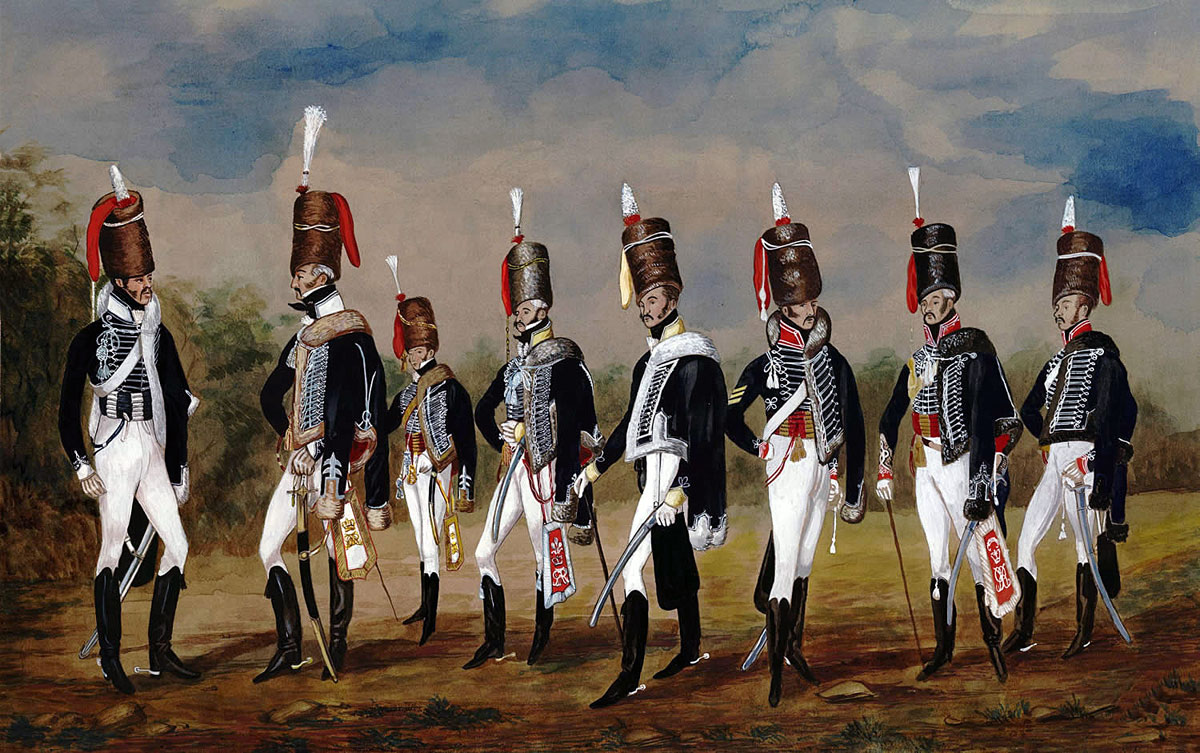
British 7th, 10th and 15th Hussars: Battle of Morales de Toro on 2nd June 1813 during the Peninsular War
The characteristics of the hussar uniform were the tight jacket braided across the front, a second pelisse jacket slung from the shoulder, fur busby hat with a colored ‘busby bag’ and cords, tight overalls and boots, a curved sword with a cross hilt. A carbine was carried on a sling or in a saddle bucket.
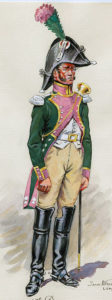
Trumpeter of the French 16th Dragoons: Battle of Morales de Toro on 2nd June 1813 during the Peninsular War
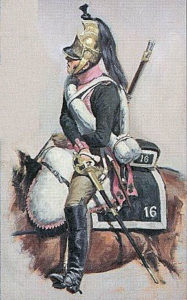
Soldier of the French 16th Dragoons: Battle of Morales de Toro on 2nd June 1813 during the Peninsular War
Hussars were the only regiments in the British Army permitted to grow moustaches.
French dragoons wore blue or green coats, white britches and heavy boots. Head-dress was a Roman-style helmet with a long horsehair plume.
Winner of the Battle of Morales de Toro: The British Hussar Brigade decisively defeated the French Brigade of the 16th and 21st Dragoons and drove them off the battlefield.
Background to the Battle of Morales de Toro:
(see britishbattles.com Battle of Vitoria for a fuller account of Wellington’s preparations in the winter of 1812/13 and his advance into Spain in April to June 1813)
The British Hussar regiments, the 10th Prince of Wales’s Own Royal Hussars, the 15th King’s Hussars and the 18th Hussars, were part of the re-inforcement sent to Wellington’s British Army in Spain during the winter of 1812/13. Forming the Hussar Brigade, these regiments arrived in Portugal from England in January 1813, before marching to the Spanish border in late April 1813.
In April 1813, Wellington began his advance into Spain for the campaign that would see the French armies defeated at the Battle of Vitoria and forced back to the border of France.
Instead of marching up the main road from Ciudad Rodrigo through Salamanca, Valladolid and Burgos to Vitoria, as most of the senior French commanders expected, Wellington crossed the Portuguese border in the north and advanced across the mountains around the French right flank.
On their way to the Spanish border, the Hussar Brigade was reviewed by Lord Wellington at Freixadas.
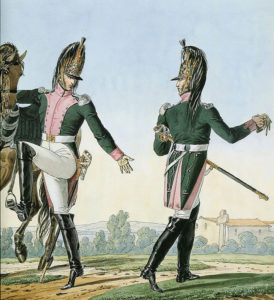
Captain and Lieutenant of the French 16th Dragoons: Battle of Morales de Toro on 2nd June 1813 during the Peninsular War: picture by Vernet
For the advance into Spain, the Hussar Brigade formed part of the column commanded by Lieutenant General Sir Thomas Graham.
The Hussar Brigade crossed the River Douro into Spain by boat in the Tras os Montes area, before marching east along the northern bank of the River Douro, reaching the River Esla on 30th May 1813.
The Esla runs north to south and had to be crossed before Wellington’s army could continue its march to the east.
The River Esla was heavily in flood and while there were several fords, the height of the river made the fords dangerous.
The Hussar Brigade crossed with considerable difficulty at Almendra.
The first party of 18th Hussars to cross the Esla captured a picket of the French 16th Dragoons. A French officer and 33 men were taken.
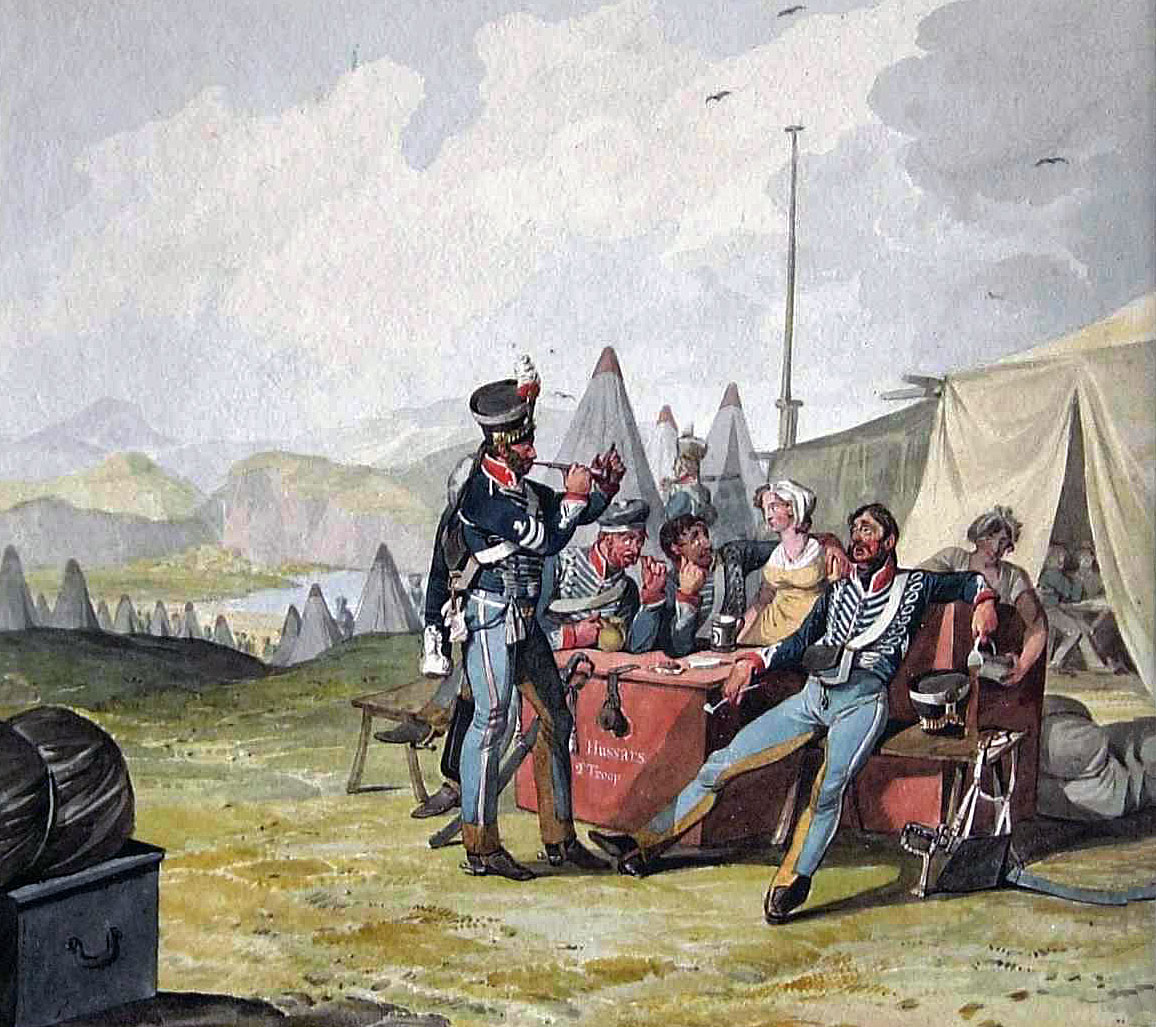
British 10th Hussars in camp: Battle of Morales de Toro on 2nd June 1813 during the Peninsular War: picture by Denis Dighton
On 1st June 1813, spear-heading General Graham’s advance, the Hussar Brigade marched into Zamora, finding the town abandoned by the French, with the bridge across the River Douro demolished.
On 2nd June 1813, the Hussar Brigade, accompanied by a battery of Horse Artillery, moved on to Toro, the next town to the east on the northern bank of the River Douro. Again, the bridge over the river had been demolished.
The Battle of Morales de Toro:
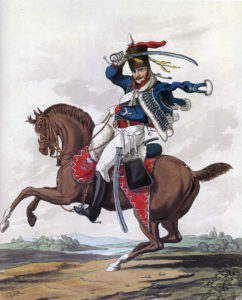
Soldier of the 10th Prince of Wales’s Own Royal Hussars: Battle of Morales de Toro on 2nd June 1813: picture by Hamilton Smith
General Digeon commanded a division of French dragoons in the village of Morales de Toro, 7 miles beyond Toro. One of Digeon’s two brigades, comprising the 5th and 12th Dragoons, was positioned on the east bank of the River Bajez, a tributary of the River Douro that flows past Morales.
Digeon’s first brigade, comprising the 16th and 21st Dragoons, was drawn up on the western side of Morales.
At dawn on 2nd June 1813, Digeon, having no reason to suspect that Wellington’s army was across the River Esla, sent a patrol of 100 men of the 16th and 21st Dragoons into Toro.
This patrol left Toro on the arrival of the British Hussars.
Soldiers of the British 18th Hussars found the French Dragoons’ breakfast, apparently precipitately abandoned.
It would seem, however, that the French patrol did not consider itself to be in any danger.
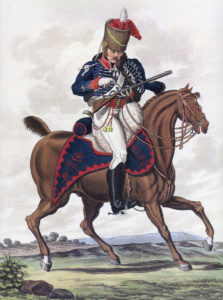
Soldier of the 15th King’s Hussars: Battle of Morales de Toro on 2nd June 1813 during the Peninsular War: picture by Hamilton Smith
The British 10th Hussars, with a squadron of the 15th Hussars, set off in pursuit of the French Dragoons, while the British 18th Hussars took a route more directly east. The 15th Hussars followed as a reserve.
General Digeon, watching the progress of his patrol from a commanding position at Morales, saw with concern that his dragoons appeared to be unaware that they were being pursued and were moving at the walk.
Digeon ordered the rest of his First Brigade to mount and advance to the support of their comrades, while he rode to the patrol to warn them of their danger.
Digeon arrived as the British Hussars came up and the 16th and 21st Dragoons quickly assumed two ranks facing the British cavalry.
The British 10th Hussars, commanded by Major Robarts, with one squadron of the 15th Hussars, charged the French Dragoons and overthrew them, penetrating both the French lines and putting the two dragoon regiments to flight.
The British 18th Hussars came up on the French left flank and, with the 15th Hussars in support, the British Hussar Brigade pursued the fleeing French Dragoons for some two miles, over the bridge across the River Bajez and across a bog, before being brought up short by a discharge from a French artillery battery positioned with Digeon’s second brigade, General Darricau having come up with both infantry and guns.
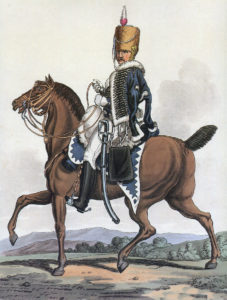
Soldier of the 18th Hussars: Battle of Morales de Toro on 2nd June 1813 during the Peninsular War: picture by Hamilton Smith
In the face of this overwhelming French force, Colonel Grant, the commander of the hussars, withdrew his brigade across the River Bajez and awaited the advance of Graham’s infantry and guns.
Casualties in the Battle of Morales de Toro:
British losses at the Battle of Morales de Toro were 1 officer, Lieutenant Cotton of the 10th, killed and 2 officers wounded, one of them taken prisoner, with 18 soldiers killed, wounded or taken prisoner.
French losses were 2 officers and 200 men killed, wounded or taken prisoner, with the loss of many horses.
Follow-up to the Battle of Morales de Toro:
On 3rd June 1813, Wellington’s right flanking divisions crossed the River Douro by the fords around Toro and joined his left flank, enabling the whole army of British, Portuguese and Spanish troops to continue the advance.
King Joseph and his French army were forced to fall back to Vitoria, where the decisive battle of 21st June 1813 took place.
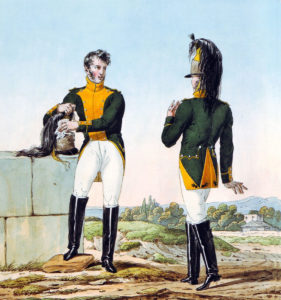
French 21st Dragoons: Battle of Morales de Toro on 2nd June 1813 during the Peninsular War: picture by Vernet
Fortescue said of the Battle of Morales de Toro: ‘Altogether this was a brilliant little affair which, when read in conjunction with other incidents of these few days, does not increase our respect for the officers of the French cavalry.’
Anecdotes and traditions from the Battle of Morales de Toro:
- One of the wounded British officers was Captain Lloyd of the 10th. Lloyd was left in the care of the French at Morales and paroled, after his recovery.
- The French were diligent in destroying bridges to hinder Wellington’s advance. During the difficult crossing of the River Esla ford, the commanding officer of the 18th Hussars, Lieutenant Colonel Murray, was severely injured and several men and horses from all three Hussar regiments were swept away.
- Lord Wellington crossed the River Douro in a basket suspended from two trees, winched from one side of the river to the other.
- In the spring of 1813 a British transport carrying horses of the 18th Hussars was captured off the coast of Portugal by an American privateer. Wellington complained of the failure of the Royal Navy to keep the Americans from raiding the shipping between Britain and Portugal. The Royal Navy riposted by pointing out that there was a significant shortage of manpower in the fleet due to the expansion of the army, which had absorbed most of the available recruits in Britain.
References for the Battle of Morales de Toro:
See the extensive list of references given at the end of the Peninsular War Index.
The previous battle of the Peninsular War is the Retreat from Burgos
The next battle of the Peninsular War is the Battle of San Millan and Osma

Podcast on the Battle of Morales de Toro: The successful cavalry action fought by the British Hussar Brigade against the French 16th and 21st Dragoons on 1st June 1813 in the Peninsular War:John Mackenzie’s britishbattles.com podcasts
